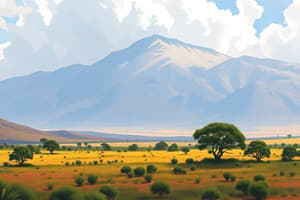Podcast
Questions and Answers
What is the normal lapse rate in the troposphere?
What is the normal lapse rate in the troposphere?
- 5°C per kilometer rise in altitude
- 8°C per kilometer rise in altitude
- 10°C per kilometer rise in altitude
- 6.5°C per kilometer rise in altitude (correct)
In what scenario does the dry adiabatic lapse rate apply?
In what scenario does the dry adiabatic lapse rate apply?
- In unsaturated air with relative humidity less than 100% (correct)
- During temperature inversions
- In saturated air with relative humidity of 100%
- At sea level only
How much does the temperature of saturated air change per 1,000 meters ascent?
How much does the temperature of saturated air change per 1,000 meters ascent?
- 6.5°C
- 8°C
- 10°C
- 5°C (correct)
What defines the environmental lapse rate?
What defines the environmental lapse rate?
Which factor contributes to the normal behavior of temperature change with altitude?
Which factor contributes to the normal behavior of temperature change with altitude?
What is the difference between weather and climate?
What is the difference between weather and climate?
How does Ethiopia's latitude affect its climate?
How does Ethiopia's latitude affect its climate?
What is true about the Earth's axial tilt?
What is true about the Earth's axial tilt?
During which event does the sun strike the Earth's equator directly?
During which event does the sun strike the Earth's equator directly?
Which of the following correctly describes altitude in relation to temperature?
Which of the following correctly describes altitude in relation to temperature?
What is a characteristic effect of the distance from the equator on temperature?
What is a characteristic effect of the distance from the equator on temperature?
What occurs during the Autumn Equinox?
What occurs during the Autumn Equinox?
Which of the following is NOT one of the controls of weather and climate?
Which of the following is NOT one of the controls of weather and climate?
Flashcards
Dry Adiabatic Lapse Rate
Dry Adiabatic Lapse Rate
The rate at which the temperature of an air parcel changes due to expansion or compression without heat exchange from external sources.
Normal Lapse Rate
Normal Lapse Rate
The change in temperature for every 1000 meters increase in altitude in the troposphere.
Wet Adiabatic Lapse Rate
Wet Adiabatic Lapse Rate
The rate at which the temperature of saturated air changes due to expansion or compression, influenced by the release or absorption of latent heat from water vapor.
Environmental Lapse Rate
Environmental Lapse Rate
Signup and view all the flashcards
Temperature Inversion
Temperature Inversion
Signup and view all the flashcards
Weather
Weather
Signup and view all the flashcards
Climate
Climate
Signup and view all the flashcards
Latitude
Latitude
Signup and view all the flashcards
Solar Insolation
Solar Insolation
Signup and view all the flashcards
Altitude
Altitude
Signup and view all the flashcards
Lapse Rate
Lapse Rate
Signup and view all the flashcards
Equinox
Equinox
Signup and view all the flashcards
Solstice
Solstice
Signup and view all the flashcards
Study Notes
Ethiopian and Horn Climate
- Ethiopia's diverse landscape and location near the equator and Indian Ocean create varied weather patterns.
Weather and Climate
- Weather: The current atmospheric conditions (temperature, pressure, humidity, wind, cloudiness, precipitation).
- Climate: The long-term average weather conditions over an extended period.
Elements and Controls of Weather and Climate
- Elements include temperature, precipitation, humidity, winds, and air pressure.
- Controls are factors influencing these elements, including latitude, land/water distribution, winds/air pressure, altitude, and ocean currents.
Latitude
- Ethiopia's latitude leads to high average temperatures, small annual temperature ranges, and minimal seasonal variations in day length.
- Latitude affects solar insolation and temperature.
Inclination of the Earth's Axis and Seasons
- The Earth's tilted axis causes seasonal changes (day length variations).
- Equinoxes: Equal day and night (around March 21 and September 23).
- Solstices: Longest (June 21) and shortest (December 22) days in the Northern Hemisphere.
Altitude and Lapse Rates
- Altitude: Height above sea level.
- Temperature Change: Generally, temperature decreases with increasing altitude.
- Lapse Rate: The rate of temperature change with altitude.
- Normal Lapse Rate: 6.5°C per kilometer (in the troposphere).
- Dry Adiabatic Lapse Rate: 10°C per 1,000 meters (unsaturated air).
- Wet Adiabatic Lapse Rate: ~5°C per 1,000 meters (saturated air).
- Environmental Lapse Rate: The actual observed temperature change with altitude in the atmosphere, often ~6.5°C per 1,000 meters, but can vary due to inversions.
Studying That Suits You
Use AI to generate personalized quizzes and flashcards to suit your learning preferences.




